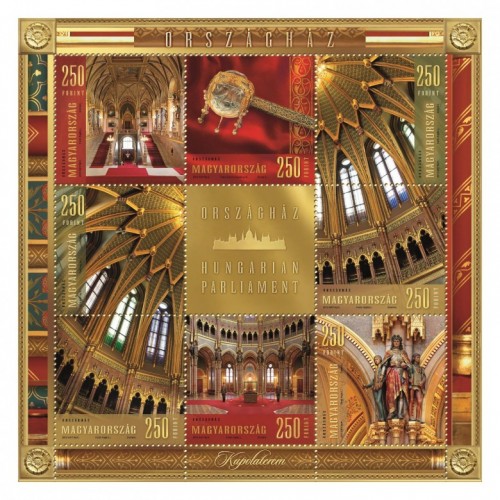
1. MAGYAR - MŰVÉSZETEK 2013: ORSZÁGHÁZ II. – KUPOLATEREM - Bélyeg vásárlás >>
2. ENGLISH - ARTS 2013: THE HOUSE OF PARLIAMENT II – THE DOME HALL - Order stamp >>
3. GERMAN - KÜNSTE 2013: PARLAMENTSGEBÄUDE II. – KUPPELSAAL - Die Bestellnummer Der Marke >>
1. MAGYAR - MŰVÉSZETEK 2013: ORSZÁGHÁZ II. – KUPOLATEREM
A magyar szentek és boldogok tematikát a Magyar Posta több évre áthúzódóan bélyegkibocsátásán keresztül mutatja be. Az első kisív bélyegképein a Szepeshelyi Szent Márton-főoltár magyar királyszenteket ábrázoló táblája látható, rajta: Szent László, Szent Imre és Szent István. A kibocsátás különlegessége, hogy a kisív alapváltozata mellett speciális változat és egyszín-nyomat is megjelenik. Kara György tervei alapján a Pénzjegynyomda gyártotta. Az újdonság augusztus 14-től kapható a nagyobb postákon valamint a Filapostán, de megrendelhető a Magyar Posta internetes áruházából is.
A boldoggá avatás és a szentté avatás annak az ünnepélyes kijelentése, hogy az elhunytat Isten felvette a szentek, illetve boldogok társaságába. III. Sándor pápa volt az első, aki megkülönböztetett egyetemesen elismert szenteket és helyi tiszteletnek örvendő boldogokat. Ekkortól használják megkülönböztetésre a sanctus (szent) és a beatus (boldog) terminusokat. A boldoggá avatás és a szentté avatás részletes rendjét VIII. Orbán pápa határozta meg, s ez csekély változtatásokkal máig érvényes. Magyarország máig több mint 50 szentet és boldogot adott a világ katolikus közösségeinek.
A filatéliai sorozat első darabja a magyar királyszenteket ábrázolja. Az egyforma magas, gondosan megmintázott figurák statikusságát egymás felé hajló attribútumok dinamizmusa ellensúlyozza. Heraldikailag jobbról a középkorú, liliomos pártázatú koronás Szent László áll. Középen az átszellemült arcú, fiatal Imre herceg látható. Mellette bal oldalt az idős, tiszteletet parancsoló Szent István király áll. Páncélzata Luxemburgi Zsigmond korát idézi, jobb kezében hosszúszárú arany jogart, baljában hatalmas országalmát tart.
(Forrás: dr. Kerny Terézia: A Szepeshelyi Szent Márton-főoltár magyar királyszenteket ábrázoló táblája c. írása)
Forrás: Posta
2. ENGLISH - ARTS 2013: THE HOUSE OF PARLIAMENT II – THE DOME HALL
The House of Parliament in Budapest is one of the most beautiful public buildings in the world. Its special architectural solutions are being processed and presented by a new philatelic series since 2012. The commemorative miniature sheet issued in 2013 as part of the series contains eight stamps capturing some distinctive features of the dome hall and the hall of the main staircase, with a section adorned by the silhouette of the Parliament in the middle. The sheet was produced by ANY Security Printing Company based on the artistic phortographs of József Hajdú and according to the design of graphic artist Eszter Domé. The novelty will be available at large post offices and Filaposta in Hungary from 3 September, but may also be purchased from Magyar Posta’s online store.
The main staircase leads from the main entrance of the House of Parliament to the dome hall, where there is a bronze bust of the designer of the building, Imre Steindl, made by Alajos Stróbl in 1904. Eight deep red, six-metre-high, four-tonne granite blocks between the columns supporting the ceiling attract the eye. The ceiling is decorated by allegorical frescoes by Károly Lotz.
The hexadecagonal, 20-metre diameter dome hall houses the Holy Crown, the sceptre, orb and sword of Hungary. The star vault is 27 metres high. The impressive hall is the structural and conceptual centre of the building. This and the wing of the main entrance were the first sections of the House of Parliament to be completed and the session celebrating the Millennium of the Hungarian Conquest was held there in 1896. The Holy Crown of Hungary was first brought into the building for this occasion, which is commemorated by the statues of pages in the main staircase bearing the crown jewels in their hands. The statues of the sixteen monarchs and their armorial bearings in the dome hall give a short overview of the one thousand years of Hungarian history. (Source: orszaghaz.hu hu.wikipedia.org)
3. GERMAN - KÜNSTE 2013: PARLAMENTSGEBÄUDE II. – KUPPELSAAL
Das Parlamentsgebäude in Budapest ist eines der schönsten öffentlichen Gebäude weltweit. Die neue philatelistische Serie verarbeitet und präsentiert seine besonderen architektonischen Lösungen seit 2012. Der als Teil der Serie 2013 erscheinende, acht Briefmarken enthaltende Sonderkleinbogen verewigt einige charakteristische Details des Kuppelsaals und der Treppenhaus-Halle, mittig ist ein Anhängsel mit der Silhouette des Parlamentsgebäudes zu sehen. Der Sonderkleinbogen wurde unter Verwendung der Kunstfotos von József Hajdú und nach den Entwürfen der Grafikerin Eszter Domé in der ANY Biztonsági Nyomda (ANY Sicherheitsdruckerei) hergestellt. Erhältlich ist die Briefmarkennovität vom 3. September in den größeren Postämtern sowie auf der Filaposta, aber sie kann auch im Webshop der Magyar Posta bestellt werden.
Die Treppenhaus-Halle führt vom Haupteingang zum Kuppelsaal des Parlamentsgebäudes, wo die Bronzebüste des Architekten Imre Steindl zu sehen ist (1904, ein Werk von Alajos Strobl). Von den Säulen, die die Decke der Halle tragen, zeichnen sich acht dunkelrote, sechs Meter hohe und vier Tonnen schwere Granitblöcke aus. Die Decke zieren allegorische Fresken von Károly Lotz.
Der sechzehneckige Kuppelsaal mit einem Durchmesser von 20 Metern beherbergt die Ungarische Heilige Krone, das Zepter, den Reichsapfel und das Schwert. Die Sternenkuppel ist 27 Meter hoch. Die imposante Halle ist das strukturelle und gedankliche Zentrum des Gebäudes. Diese war zusammen mit der Seite am Haupteingang der am frühesten fertig gestellte Teil des Parlamentsgebäudes, denn hier wurde bereits 1896 eine feierliche Sitzung anlässlich des Millenniums abgehalten. Aus diesem Anlass wurde die Ungarische Heilige Krone das erste Mal in das Gebäude gebracht, woran die im Haupttreppenhaus platzierten, die Insignien in den Händen haltenden Pagen-Statuen erinnern. Im Kuppelsaal geben Statuen und Wappenschilder von sechzehn Herrschern einen kurzen Überblick über Ungarns tausendjährige Geschichte. (Quelle. orszaghaz.hu hu.wikipedia.org)










